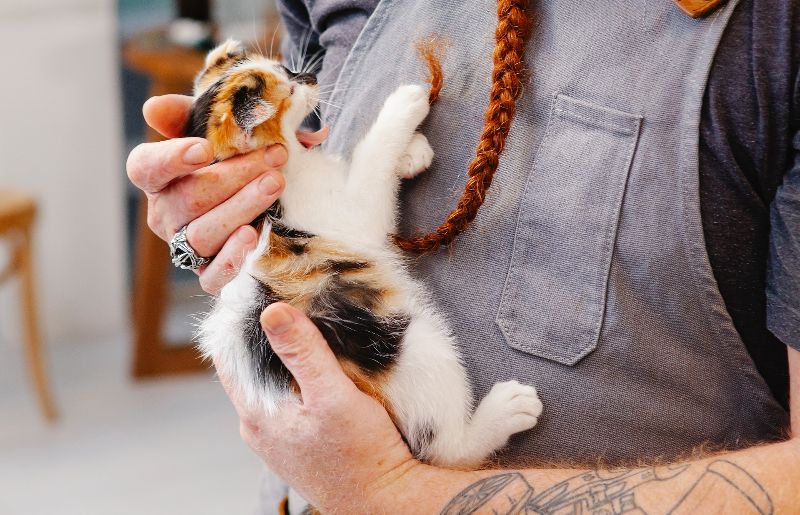How Much to Feed a Kitten (with Kitten Feeding Chart)
By Kit Copson
Updated on

Kittens are in an important developmental phase of their lives, so their nutritional needs differ from those of fully-grown, adult cats. There is no one-size-fits-all approach to feeding a kitten as it varies depending on how old they are, how much they weigh, and other factors. Just to give you an idea, though, a kitten at 6 weeks of age eats around 1/4 to 1/3 of a cup of food per day.
In this post, we’ll explore the nutritional needs of kittens and share a feeding chart to give you an approximation of how much they should be eating at different ages.
What Are a Kitten’s Dietary Requirements?
In addition to being in the crucial growth stage, kittens are full of energy and curious about the world, which means they need more protein in the form of a high-quality diet to support a healthy weight and bone and muscle development. They also need higher amounts of nutrients like calcium and phosphorus and more calories per cup than adult cats.
To make sure your kitten gets all the nutrients they need as described above, you’ll need to acquire a high-quality commercial cat food formulated specifically for kittens (not for adult cats).
On the other hand, if your kitten is just a few days or weeks old and isn’t able to receive milk from their mother, you’ll need to feed them a special milk replacement formula for kittens from a bottle. Kittens are typically weaned from their mother at around 4–6 weeks old.
When your kitten is 5 weeks old, this is the point where you can start gradually introducing them to solid kitten food (more on this further down.)

How Much Should I Feed My Kitten?
This really depends on its size and weight and how old your kitten is. Luckily, most kitten food brands will include a feeding chart on their packaging, and this is a great guide to follow. That said, every kitten has individual needs, so if you have any concerns about how much you should be feeding your kitten and need extra advice, your vet is the person to go to.
In the meantime, below are two charts showing approximately how much kittens at various stages in the development phase should eat and how often.
Kittens Up to 4–5 Weeks
These are the recommended guidelines for feeding a kitten on a milk replacement formula. Please never feed your kitten cow milk—stick to formulas designed especially for kittens.
When your kitten is 4–5 weeks of age and starts weaning off their kitten formula (or mother’s milk), you can start to introduce solid food by mixing a little into the kitten formula. From 5 weeks, you can start giving them solid food with a bowl of water—it’s time for them to start learning how to eat and drink from a bowl by themselves.
You can slowly decrease the amount of formula you were previously feeding (more on this below).

Note: These charts only offer general guidelines. There will be variations between the different products according to their calorie content. Please consult your vet if you’re unsure how much to feed your kitten, if your kitten is underweight, or if your kitten has any health conditions.
| Age | Amount | Frequency |
| 0–1 week | 2–6 ml | Every 2 hours |
| 1–2 weeks | 6–10 ml | Every 2–3 hours |
| 2–3 weeks | 10–14 ml | Every 3–4 hours |
| 3–4 weeks | 14–18 ml | Every 4–5 hours |
| 4–5 weeks | 18–22 ml | Every 5–6 hours |
| 5–6 weeks | Transition to solid food | Every 6 hours |

Kittens Older Than 6 Weeks
Dr. Jamie Whittenburg from Cat World recommends feeding kittens aged between 6 and 12 weeks wet food to get them used to both dry and wet foods as early as possible. Here are some general guidelines, but again, please check the feeding guide on your kitten’s food or ask your vet if you have any concerns.
| Age | Weight | Approximate Amount of Solid Food Per Day |
| 6 weeks | 2/3 to 1-1/3 lbs | 1/4 to 1/3 cup |
| 7 weeks to 5 months | 1-1/2 to 5-3/4 lbs | 1/3 to 2/3 cup |
| 6 months to 1 year | 5-3/4 to 12 lbs | 2/3 to 1 cup |

How Often Do Kittens Need to Eat?
Kittens under 2 weeks old that are bottle feeding need to be fed formula at least every 2 hours, which goes up to every 3–4 hours between the ages of 2–4 weeks.
Kittens between the ages of 6–16 weeks need to be fed several small meals throughout the day—between three and six to be more precise. PetMD recommends feeding kittens of this age every 6–8 hours. From the age of 4–5 months, kittens start switching to two meals per day—the standard number for adult cats.
One thing to bear in mind is that it’s a good idea to get your kitten used to a feeding schedule by splitting their daily food allowance into portions. Cats need this kind of routine as it gives them a sense of security and makes sure they’re eating at the times they need it most.
Conclusion
Getting a kitten is a wonderful and exciting chapter in your life, but feeding them—especially very young kittens that can’t be fed by their mothers—can be a bit confusing if you’ve never done it before.
Don’t worry—if you’re ever in doubt, get in touch with your vet to ask for advice. They’ll be able to tell you exactly how much your kitten needs to be fed, how often, and for how long based on their age, weight, and health condition.
Featured Image Credit: Gosha-Georgiev, Shutterstock











